Having taken one drink too many the night before (it's more like earlier in the morning), I rose at 11am. That's darn late by my standards. After a quick wash, I dragged myself down to the dining hall for brunch. Not bad really.
Anyway, it was a Saturday, and I had no intention of staying in my room completing my work (though I probably SHOULD have). I also needed to 'walk' the effects of the alcohol away. I decided upon visiting RC churches in the vicinity, since I quite enjoy looking at Church Architecture.
Armed with my Digiam, London A-Z guide and some notes I wrote down from www.rcdow.org.uk, I set off in good spirits.
My first stop was the Church of St Aloysius Gonzaga, a short walk from HPH. This is the parish of Somers Town.
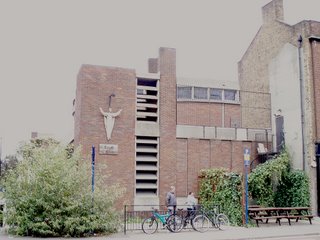
I guess this is what they call a "Modern" Church over here. It may not have the Neo-Byzantine architecture of Westminster Cathedral, but it's beautiful in it's own right. And it certainly does have a lot to offer.
Just a little history, St Aloysius Gonzaga was born in 9 March 1568 at Lombardi, Italy. He was born a noble, and was the son of a compulsive gambler. Eventually becoming a member of the Jesuit community, he cared for Plague victims in Rome during the 1591 Plague Outbreak. In the end, he became a Plague victim himself and departed on 21 June 1951 in Rome. Canonized in 31 December 1726 by Pope Benedict XIII, he is the patron saint for AIDS Patients and AIDS caregivers.

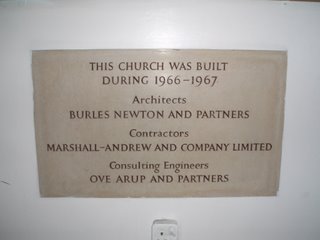
These 3 stones pretty much sum up the brief but rich history of the church itself.
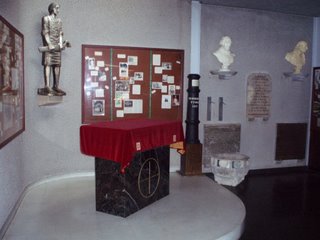
And this is the history corner, where there are write-ups and photographs of the various significant events that have taken place in this humble parish since it was built.
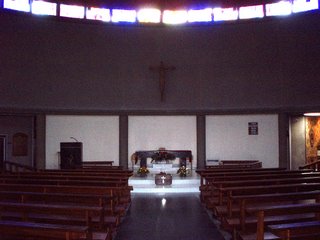
That's the view from the entrance.
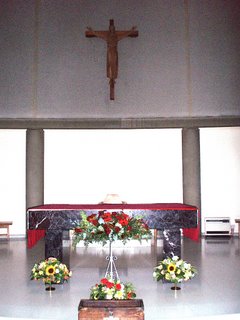
A closer view of the altar

The tabernacle
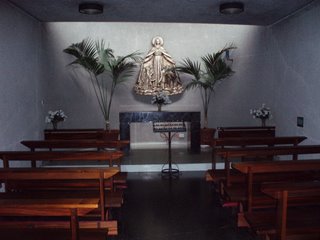
The chapel on the side
Having said a quick prayer, I felt ready to embark on the long journey to my next Church.
The journey to the next parish took quite some time. The bulk of the walking was along Euston / Marylebone Road. There were some rather eye-catching events taking place along the way. There were also some places of interest.
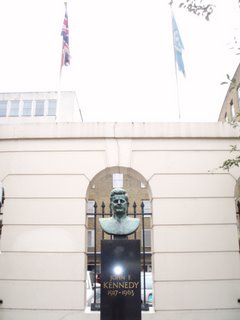
That was part of the JFK International Students' Hostel or something like that.

Madame Tussauds. The queue was quite long. The dome-shaped thing popping out on the left is the Planetarium.

A wedding! Taking place at the Westminster Town Council. One of the few weddings I'd encounter on this day. I think the couple were Indian. Bless them.

I have never seen such a large row of Pinkish Red (or Reddish Pink, whichever way you look at it) Houses in my life.
And so after over an hour of non-stop walking, I arrived at my second destination for the day. This is the Church of Our Lady of the Rosary, also known as the Marylebone Parish.

The outside is quite nice really.
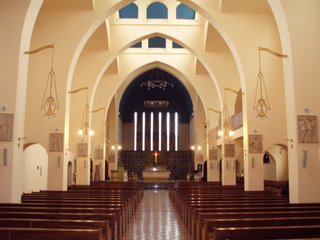
The view from the entrance. Fairly majestic.
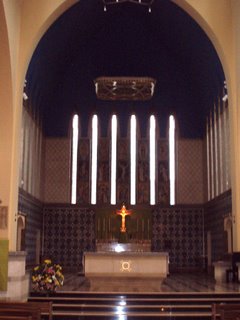
A closer view of the altar.
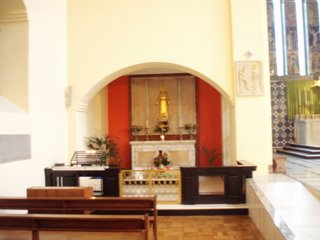
Another of those side chapels. Too bad I could not find out what the Chapel was called.
Unfortunately, I was not able to find out any history about this beautiful Parish. No worries, I made a small contribution to the Church funds, prayed, then continued on.
This time, I passed by Edgeware Road. This was probably where the Moroccan Community can be found. There were lots of Halal Restaurants selling kebabs. I was rather tempted to get myself some, but I refrained from doing so, keeping my budget in mind.
This leg of the journey was not as long. I reached The Church of St James, also known as the Spanish Place Parish.

Arguably the most Majestic destination for the day. There were lots of people outside because a wedding (another one!) had just taken place. Beautiful day indeed.

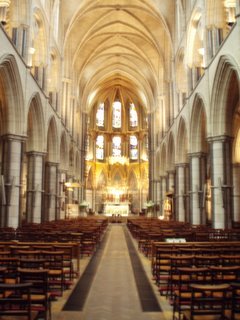
As usual, I will start with views from the entrane. The former was taken with flash. Which do you think is nicer?
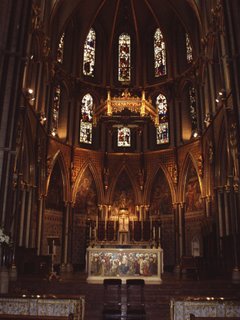
Closer view of the altar. With flash.
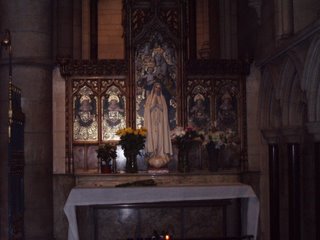
Statuette of Mother Mary. From one of the many side chapels that this church has.
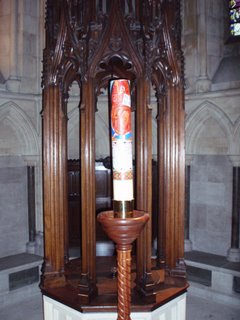
Paschal Candle. First one I've seen today.
Once again, there was no information about the history of this parish. It would have been nice to learn more about this architectural marvel.
My final destination for the day was the Ogle Street Parish, or the Church of St Charles Borromeo.
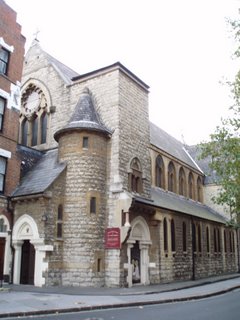
It's a pity the church is sort of "blocked" in the front. I mean, it does really look quite nice.
Saint Charles Borromeo was born in Aron, Italy on 2 October 1538. His life focused mainly on helping the poor. Eventually becoming a Cardinal, he was the Archbishop of Milan. He also happened to be a teacher and parish priest to Saint Aloysius Gonzaga. Having succmbed to fever, he was called home on 3 November 1584. He was canonized by Pope Paul V on 1 November 1610.
When I entered the church, there was this old man walking up and down the side of the church, praying the Rosary. It was a bit scary.
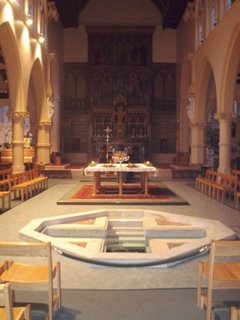
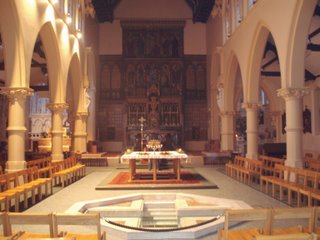
View from the entrance. This is quite a small parish. I think it can only seat less than 200 people. And unlike most other churches where the congregation is in front of the Altar, the Altar here is surrounded by the congregation. Does really add to the cosy community feel.
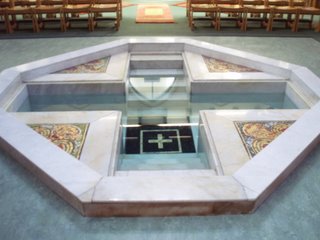
The Baptismal Pool. The word Baptism really means "Plunging" so here Catholics to-be are immersed into to water. There are 7 steps leading to the bottom of the pool, representing the 7 Deadly Sins. At the bottom of the pool, the Old Person dies, and the New Person is reborn. The 7 steps out of the pool represent the 7 Blessings of the Holy Spirit.
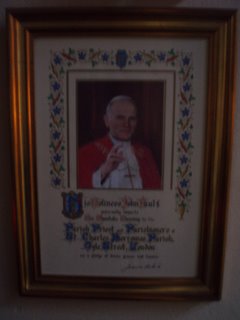
The Papal Blessing by Pope John Paul II. The unique feature of the Papal Blessing (compared to Papal Blessings of most other churches) is that it was signed by the Pope himself, not someone signing on his behalf.
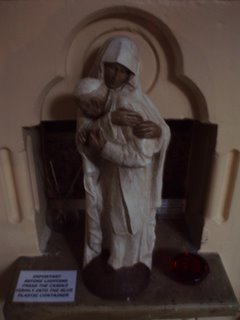
A statuette of Mary comforting Pope John Paul II
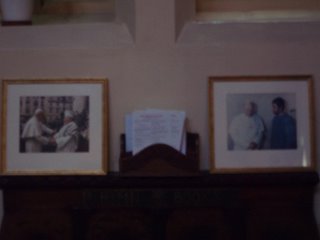
As you can already tell, the are lots of allusions to Pope John Paul II in this church. Here are photos of the 2 rather significant events during his papacy: On the left, Pope John Paul II meets the leader of the Jews in Rome. On the right, he meets Mehmet Ali Agca, the Turkish gunman who shot Pope John Paul II and left him in a critical condition. The Pope survived, and forgave Mehmet later on. Not something easy to do if you ask me.
It turns out that the gentleman praying the rosary on the side of the church was Father Alan Fudge, the Parish Priest. I also chanced upon a lady preparing flowers for the Altar at mass. At the basement, a group of African women were having a prayer session for peace in their homeland. A rather cosmopolitan Church indeed.
This marked the end of my mini pilgrimage. It was spiritually enriching, and also a feast for the eyes in terms of architecture. Best of all, I spent 0.00 pounds for this whole journey.
I hope that my DFRs liked the photos and found this little write-up informative. When I do have the time, I will go exploring again sometime soon.
Better do some proper work now.
Cheers mate.
Anyway, it was a Saturday, and I had no intention of staying in my room completing my work (though I probably SHOULD have). I also needed to 'walk' the effects of the alcohol away. I decided upon visiting RC churches in the vicinity, since I quite enjoy looking at Church Architecture.
Armed with my Digiam, London A-Z guide and some notes I wrote down from www.rcdow.org.uk, I set off in good spirits.
My first stop was the Church of St Aloysius Gonzaga, a short walk from HPH. This is the parish of Somers Town.

I guess this is what they call a "Modern" Church over here. It may not have the Neo-Byzantine architecture of Westminster Cathedral, but it's beautiful in it's own right. And it certainly does have a lot to offer.
Just a little history, St Aloysius Gonzaga was born in 9 March 1568 at Lombardi, Italy. He was born a noble, and was the son of a compulsive gambler. Eventually becoming a member of the Jesuit community, he cared for Plague victims in Rome during the 1591 Plague Outbreak. In the end, he became a Plague victim himself and departed on 21 June 1951 in Rome. Canonized in 31 December 1726 by Pope Benedict XIII, he is the patron saint for AIDS Patients and AIDS caregivers.


These 3 stones pretty much sum up the brief but rich history of the church itself.

And this is the history corner, where there are write-ups and photographs of the various significant events that have taken place in this humble parish since it was built.

That's the view from the entrance.

A closer view of the altar

The tabernacle

The chapel on the side
Having said a quick prayer, I felt ready to embark on the long journey to my next Church.
The journey to the next parish took quite some time. The bulk of the walking was along Euston / Marylebone Road. There were some rather eye-catching events taking place along the way. There were also some places of interest.

That was part of the JFK International Students' Hostel or something like that.

Madame Tussauds. The queue was quite long. The dome-shaped thing popping out on the left is the Planetarium.

A wedding! Taking place at the Westminster Town Council. One of the few weddings I'd encounter on this day. I think the couple were Indian. Bless them.

I have never seen such a large row of Pinkish Red (or Reddish Pink, whichever way you look at it) Houses in my life.
And so after over an hour of non-stop walking, I arrived at my second destination for the day. This is the Church of Our Lady of the Rosary, also known as the Marylebone Parish.

The outside is quite nice really.

The view from the entrance. Fairly majestic.

A closer view of the altar.

Another of those side chapels. Too bad I could not find out what the Chapel was called.
Unfortunately, I was not able to find out any history about this beautiful Parish. No worries, I made a small contribution to the Church funds, prayed, then continued on.
This time, I passed by Edgeware Road. This was probably where the Moroccan Community can be found. There were lots of Halal Restaurants selling kebabs. I was rather tempted to get myself some, but I refrained from doing so, keeping my budget in mind.
This leg of the journey was not as long. I reached The Church of St James, also known as the Spanish Place Parish.

Arguably the most Majestic destination for the day. There were lots of people outside because a wedding (another one!) had just taken place. Beautiful day indeed.


As usual, I will start with views from the entrane. The former was taken with flash. Which do you think is nicer?

Closer view of the altar. With flash.

Statuette of Mother Mary. From one of the many side chapels that this church has.

Paschal Candle. First one I've seen today.
Once again, there was no information about the history of this parish. It would have been nice to learn more about this architectural marvel.
My final destination for the day was the Ogle Street Parish, or the Church of St Charles Borromeo.

It's a pity the church is sort of "blocked" in the front. I mean, it does really look quite nice.
Saint Charles Borromeo was born in Aron, Italy on 2 October 1538. His life focused mainly on helping the poor. Eventually becoming a Cardinal, he was the Archbishop of Milan. He also happened to be a teacher and parish priest to Saint Aloysius Gonzaga. Having succmbed to fever, he was called home on 3 November 1584. He was canonized by Pope Paul V on 1 November 1610.
When I entered the church, there was this old man walking up and down the side of the church, praying the Rosary. It was a bit scary.


View from the entrance. This is quite a small parish. I think it can only seat less than 200 people. And unlike most other churches where the congregation is in front of the Altar, the Altar here is surrounded by the congregation. Does really add to the cosy community feel.

The Baptismal Pool. The word Baptism really means "Plunging" so here Catholics to-be are immersed into to water. There are 7 steps leading to the bottom of the pool, representing the 7 Deadly Sins. At the bottom of the pool, the Old Person dies, and the New Person is reborn. The 7 steps out of the pool represent the 7 Blessings of the Holy Spirit.

The Papal Blessing by Pope John Paul II. The unique feature of the Papal Blessing (compared to Papal Blessings of most other churches) is that it was signed by the Pope himself, not someone signing on his behalf.

A statuette of Mary comforting Pope John Paul II

As you can already tell, the are lots of allusions to Pope John Paul II in this church. Here are photos of the 2 rather significant events during his papacy: On the left, Pope John Paul II meets the leader of the Jews in Rome. On the right, he meets Mehmet Ali Agca, the Turkish gunman who shot Pope John Paul II and left him in a critical condition. The Pope survived, and forgave Mehmet later on. Not something easy to do if you ask me.
It turns out that the gentleman praying the rosary on the side of the church was Father Alan Fudge, the Parish Priest. I also chanced upon a lady preparing flowers for the Altar at mass. At the basement, a group of African women were having a prayer session for peace in their homeland. A rather cosmopolitan Church indeed.
This marked the end of my mini pilgrimage. It was spiritually enriching, and also a feast for the eyes in terms of architecture. Best of all, I spent 0.00 pounds for this whole journey.
I hope that my DFRs liked the photos and found this little write-up informative. When I do have the time, I will go exploring again sometime soon.
Better do some proper work now.
Cheers mate.

0 Comments:
Post a Comment
<< Home